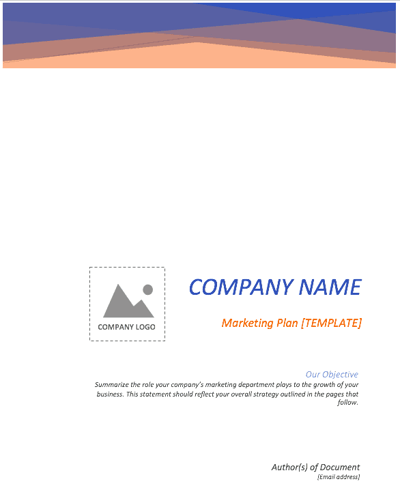Do you take a good, hard look at your team's marketing strategy every year?
You should. An annual marketing plan helps you set your marketing on the right course to make your company's business goals a reality. Think of it as a high-level plan that guides the direction of your team's campaigns, goals, and growth.
Without one, things can get messy -- and it's nearly impossible to put a number on the budget you'll need to secure for the projects, hiring, and outsourcing you'll encounter over the course of a year if you don't have a plan.
Keep in mind there are variations to the marketing plan you need, depending on your industry and the goals of your marketing team. To make your plan's creation easier, we've put together a list of what to include in your plan and a few different planning templates where you can easily fill in the blanks.
To start, let's take a look at what a high-level marketing plan has inside.
Marketing Plan Elements
Marketing plans can get quite granular to reflect the industry you're in, whether you're selling to consumers (B2C) or other businesses (B2B), and how big your digital presence is. Nonetheless, here are six elements every effective marketing plan includes:
1. Business Summary
In a marketing plan, your Business Summary is exactly what it sounds like: a summary of the organization. This includes the company name, where it's headquartered, and its mission statement -- all of which should be consistent with the business as a whole.
Your marketing plan's business summary also includes a SWOT analysis, which stands for the business's strengths, weaknesses, opportunities, and threats. Be patient with your business's SWOT analysis; you'll write most of it based on how you fill out the next few marketing plan elements below.
2. Business Initiatives
The Business Initiatives element of a marketing plan helps you segment the various goals of your department. Be careful not to include big-picture company initiatives, which you'd normally find in a business plan. This section of your marketing plan should outline the projects that are specific to marketing. You'll also describe the goals of those projects and how those goals will be measured.
3. Target Market
Here's where you'll conduct some basic market research. If your company has already done a thorough market research study, this section of your marketing plan might be easier to put together.
Ultimately, this element of your marketing plan will help you describe the industry you're selling to, an analysis of your competitors, and your buyer persona. A buyer persona is a semi-fictional description of your ideal customer, focusing on traits like age, location, job title, and personal challenges.
4. Market Strategy
Your Market Strategy uses the information included in your Target Market section to describe how your company should approach the market. What will your business offer your buyer personas that your competitors aren't already offering them?
In a full-length marketing plan, this section can contain the "seven Ps of marketing." These Ps are product, price, place, promotion, people, process, and physical evidence. (You'll learn more about these seven sub-components inside our free marketing plan template, which you can download below.)
5. Budget
Don't mistake the Budget element of your marketing plan with your product's price or other company financials. Your budget describes how much money the business has allotted the marketing team to pursue the initiatives and goals outlined in the elements above.
Depending on how many individual expenses you have, you should consider itemizing this budget by what specifically you'll spend your budget on. Example marketing expenses include a marketing agency, marketing software, paid promotions, and events (those you'll host and/or attend).
6. Marketing Channels
Lastly, your marketing plan will include a list of your marketing channels. While your company might promote the product itself using certain ad space, your marketing channels are where you'll publish the content that educates your buyers, generates leads, and spreads awareness of your brand.
If you publish (or intend to publish) on social media, this is the place to talk about it. Use the Marketing Channels section of your marketing plan to lay out which social networks you want to launch a business page on, what you'll use this social network for, and how you'll measure your success on this network. Part of this section's purpose is to prove to your superiors, both inside an outside Marketing, that these channels will serve to grow the business.
Businesses with extensive social media presences might even consider elaborating on their social strategy in a separate social media plan template -- which you can download below.
Free Marketing Plan Template [Word]
Now that you know what to include in your marketing plan, it's time to grab your marketing plan template and see how best to organize the six elements explained above. The following marketing plan template opens directly in Microsoft Word, so you can edit each section as you see fit:

Download your marketing plan template here.
In this marketing plan template, you'll get to fill in the following contents to suit your company:
Business Summary
- Company Name
- Marketing Leadership Team
- Headquarters, Office Locations
- Mission Statement
- SWOT Analysis
Business Initiatives
- Overarching company initiatives
- Marketing initiatives, goals, metrics
Target Market
- Industry Name
- Buyer Persona(s)
- Competitive Analysis
Market Strategy
- Product
- Price
- Promotion
- People
- Process
- Physical Evidence
Budget
Marketing Channels
Social Media Marketing Plan Templates
As marketing departments grow, so will their presence on social media. And as as their social media presence grows, so will their need to measure, plan, and re-plan what types of content they want to publish across each network.
If you're looking for a way to deepen your social media marketing strategy -- even further than the marketing plan template above -- the following collection of social media marketing plan templates is perfect for you:
Download 10 social media reporting templates here.
In the above collection of marketing plan templates, you'll get to fill in the following contents (and more) to suit your company.
- Annual social media budget tracking
- Weekly social media themes
- Required social media image dimension key
- Pie chart on social media traffic sorted by platform
- Social media post calendar and publish time
Simple Marketing Plan Template
Of course, this type of planning takes a lot of time and effort. So if you're strapped for time before the holidays, give our new Marketing Plan Generator a try. This tool simplifies yearly planning and lays your strategies, initiatives, and goals out in a simple template so you can identify what's most important for the coming year.
Try our free Marketing Plan Generator here.
Once you've filled in your information, you'll come away with a plan that helps you:
- Outline your annual marketing strategy
- Identify your most important annual initiatives
- Nix the projects that won't help you hit your 2017 goals
- Track the right metrics throughout the year
- Align your team through a common mission
Pro Tip: The best way to set up your marketing plan for the year is to start with quick wins first, that way you can ramp up fast and set yourself (and your team) up to hit more challenging goals and take on more sophisticated projects by Q4. So, what do you say? Are you ready to give it a spin?


No comments:
Post a Comment